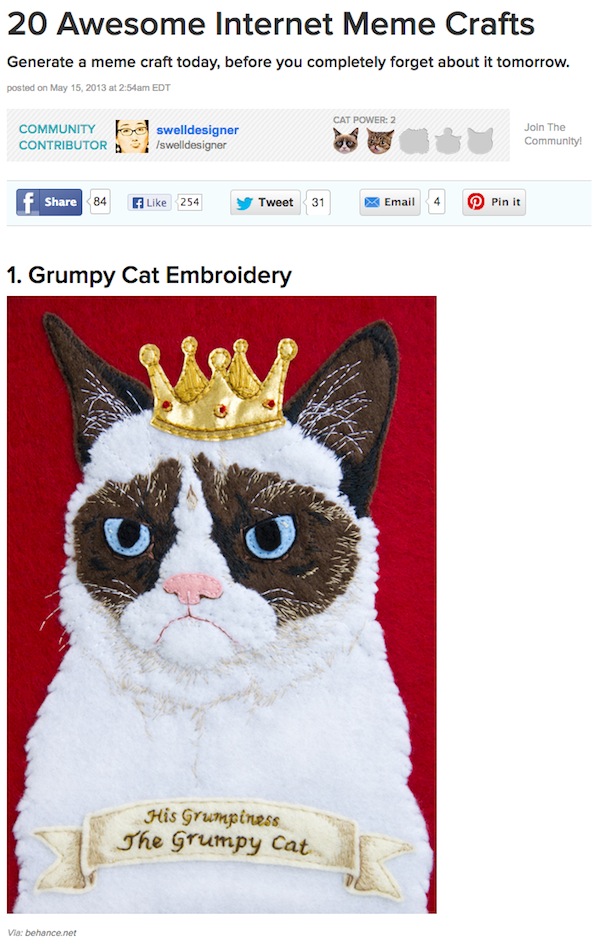
Lately, the news around BuzzFeed is all about how serious they are. They’re getting into longform. They’re fixing breaking news. They’re hiring big names from The New York Times.
But that doesn’t mean the good people of BuzzFeed have forgotten where they came from — what community editor (and animals editor!) Jack Shepherd calls the site’s “bread and butter.”

The department devoted to creating this “old school” content is known as BuzzTeam. Their focus is anything shareable — lists, animals, nostalgia. The kind of content that BuzzFeed’s loyal readers have become hyper-familiar with. Many, in fact, have consumed so many such BuzzFeed posts that they’ve become adept at mimicking both their tone and their viral success.
Earlier this month, BuzzFeed’s editors took a step toward giving those faithful followers a little more of the spotlight they crave. Shepherd, along with a staff of four, now run BuzzFeed Community, a content-producing vertical of its very own, complete with featured posts by community members and a leaderboard with the latest on who’s posts are getting the most traffic, likes, comments, and badges. It’s a competitive place, and anyone can join and enter the fray.
Success generally comes to those who enjoy making post after post, learning the audience and predicting what they will like. Shepherd says active, productive, and successful communtiy members are the kind of people who are Internet-obsessed. “They’re aware of how long a particular image has been around, what its currency is, whether it will come back or whether it’s old,” he said, laughing. “They’ll always let us know. “
This community has existed since the early days of BuzzFeed. The site’s community moderator, Cates Holderness, was boarding and grooming dogs at a kennel in North Carolina when she first discovered the site. “After a long day at work, posting on BuzzFeed was both a creative outlet for me as well as a way to relax and have fun. I got great feedback from the other users, who were very supportive and encouraging.”
#FF —> @buzzfeeders, where the best of the @buzzfeed Community will be featured!
— Cates Holderness (@catesish) May 8, 2013
@catesish @buzzfeeders @buzzfeed You mean like @tonydac??? :D buzzfeed.com/tonydac/9-ways…
— Leslie Stewart (@darlingstewie) May 8, 2013
@darlingstewie@tonydac Yep! Exactly like that!
— BuzzFeed Community (@BuzzFeeders) May 8, 2013
@buzzfeeders @tonydac Tony is just so smart and funny. He was the first friend I had on Twitter and he is just an all around NICE GUY
— Leslie Stewart (@darlingstewie) May 8, 2013
#ff @darlingstewie thanks for being awesome! You’re so supportive and helpful! Internet!
— tonydac (@tonydac) May 8, 2013
@tonydac INTERNETTTT
— Leslie Stewart (@darlingstewie) May 8, 2013
Holderness got so good at making posts — and scoring badges from staffers — that she ended up talking with Shepherd about a job, and was eventually hired to manage and interact with the site’s growing commenter base. She says the Community staff spends a lot of time engaging with users, encouraging them to make more posts and awarding them various badges. But her greatest power is the ability to promote posts, placing them on the featured Community page, or suggesting them to the editors of other verticals. Holderness says the Community team reads every single post that’s made.
Now, partially in hopes of finding others like her, Shepherd has opened that community up. The CMS for community members was originally built to allow potential hires to make sample posts, he says. But what the new vertical offers, in addition to centralized Featured Posts and a way to view the Community contributions all at once, is a leaderboard. (At the moment, WhittyGolden is edging out swelldesigner for the top spot, powered by posts like “Ten American Idol Judges Whose Opinion You’d Actually Respect” and “Why It Would Have Totally Rocked To Be A Huxtable.”)
“Now they have a community board that also lets you see how you rank against other community members,” says Community member Alexa Westerfield, “so that brings out my competitive spirit.” That sense of competition is key, because along with the new vertical, BuzzFeed community members now also have a new currency for measuring how well they’re doing: Cat Power. (Not that Cat Power.)
 “I know that on Reddit, people get really obsessed with how much karma they have. That totally works for them, but I don’t think that’s our model in any way,” says Shepherd. “Cat Power, actually, it’s kind of silly, but it actually correlates directly with an actual thing. The higher your Cat Power is, the more posts you can suggest to our community editors for consideration.”
“I know that on Reddit, people get really obsessed with how much karma they have. That totally works for them, but I don’t think that’s our model in any way,” says Shepherd. “Cat Power, actually, it’s kind of silly, but it actually correlates directly with an actual thing. The higher your Cat Power is, the more posts you can suggest to our community editors for consideration.”
Community users can create as many posts as they want, but they can only promote a few. The better their posts are, the more Cat Power they get, the more access to editors they have, which in turn means more promotion, audience, and views. Building a relationship with the editors can be lucrative — Shepherd says there’s an active freelancing network to pay users, and lately BuzzFeed fellowships have been given to frequent posters. Shepherd calls the new vertical “small scaffolding to help people naturally” ascend the steps of the hiring process — and he says the Community editing team will expand within the year.
Hundreds of applications for the @buzzfeeduk writer job. Best way to stand out from the pack: sign up + start posting buzzfeed.com/community
— Luke Lewis (@lukelewis) May 16, 2013
Those jobs are major incentives for BuzzFeed Community members. A cursory examination of frequent posters finds the vast majority seem to be journalism students, budding comedians, or both. Frequent users said that creating posts for BuzzFeed offers built in access to an audience of a size it would be impossible to reach otherwise. “I had a blog for five years that literally nobody read,” says Shepherd.
Writes Travis Greenwood, a top ranked Community member currently in marketing: “My community posts have been linked by National Geographic, Time, Huffington Post, Jezebel, Babble (a Disney property), ET.com, Complex, Fark, Mental Floss, Team Coco, IFC, Glamour, and dozens of other prominent sites (in other words, big, established editorial brands that probably wouldn’t give me the time of day otherwise). On a basic level, BuzzFeed is a marketplace of ideas and I want to compete in this arena. Pushing something onto the homepage is like jumping onto the diamond with the Red Sox (I’m from Boston).”
Of course, media companies hiring popular commenters as writers is nothing new. “We have a long tradition of hiring people who love the site and organically discover how to make really great BuzzFeed posts,” says Shepherd. And as Matthew Ingram wrote a few weeks ago, it’s happened at The Atlantic, Wired, and Gawker — and Gawker’s new Kinja platform seems expressly built for the purpose of surfacing talent.
Community members are also using BuzzFeed as an opportunity to learn about audience desires. They get access to a BuzzFeed dashboard that tracks tweets, links, and views, and, through editors, can have their success tracked by BuzzFeed’s algorithm.
“People love to see posts that reflect them or impact them. That’s just a rule of journalism,” wrote Austin Carroll. “As a journalism student, I do hope to get hired by BuzzFeed (currently that is in the talks of happening soon). However, I am mostly a narrative televison writer and therefore this experience has given me valuable insight into what people relate to, what they find funny, and what they want to talk about and share.”
So while they may be creating heavily branded and highly popular content for free, it’s not as though BuzzFeed’s Community users walk away empty handed. But what is BuzzFeed hoping to will come of the project?
“I would love to see a large core of users genuinely competing with the editors. It’s always the case with big sites, and it’s true for us as well, that the percentage of registered users versus the percentage of people who are dedicated and active — the latter is very small,” says Shepherd. “I would consider this to be a success if we got really good at focusing on that percentage and growing that and giving them the attention they wanted and mkaing it a good experience. Getting it to a point where they could kind of compete with the editors.”
I asked Shepherd whether they’re concerned about users repackaging staffer ideas, or vice versa. On Twitter, some voiced even more serious concerns.
Starting a pool: How long before BuzzFeed gets sued for something someone posts in its Community section?
— Nicholas Jackson (@nbj914) May 15, 2013
But Shepherd said, while Community wasn’t built to help editors pad the other verticals, if users end up making content that’s more popular than what staffers make, that’s all right. “Maybe from there,” he says, “there will be entirely new post types that we never thought of that really work because they’re being crowdsourced or being collaborative.”
Photo by Roger H. Goun used under a Creative Commons license.